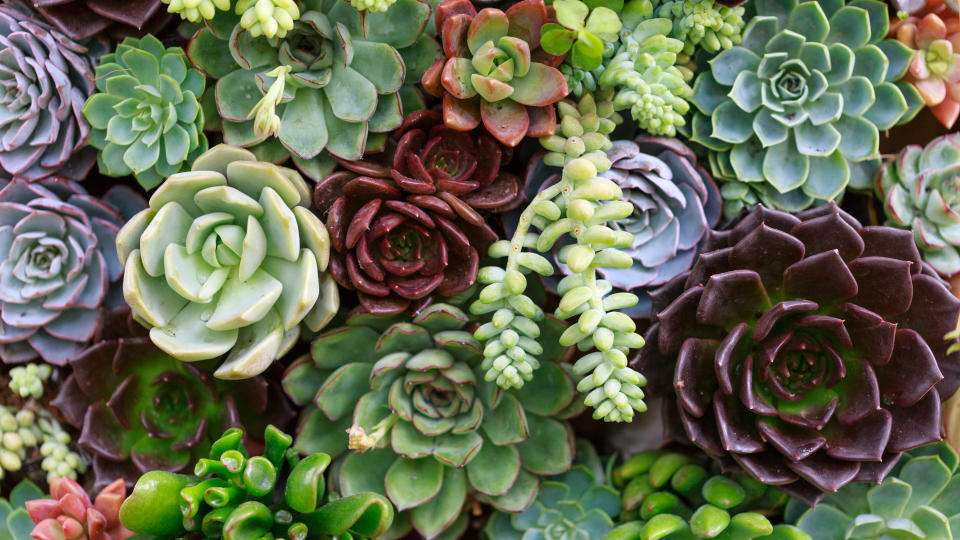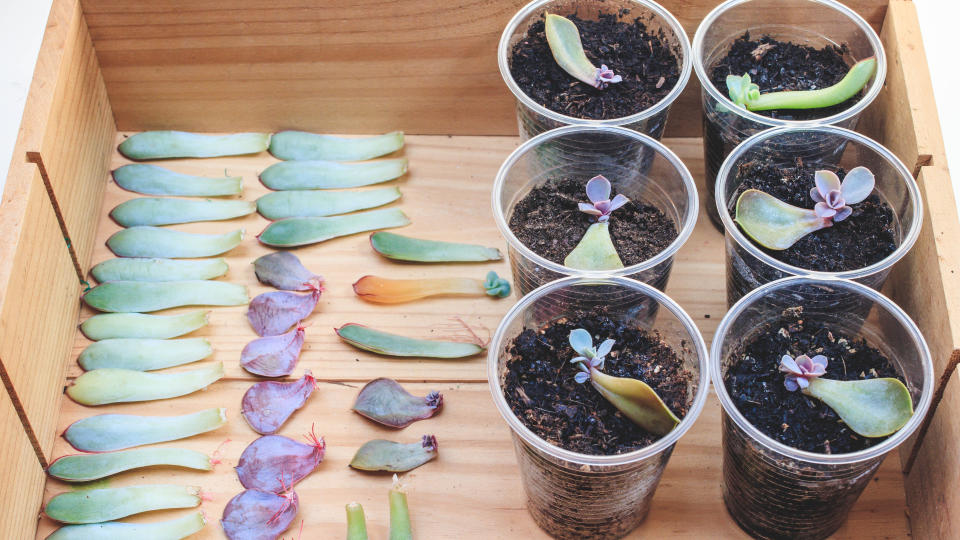Grow Your Own Succulent Garden, Plus How To Grow New Succulents From Their Leaves!
- Oops!Something went wrong.Please try again later.
Succulents are one of the most popular plants thanks to their sculptural form and low-maintenance nature. Hardy and easygoing, they’re also fantastic plants for propagating, which means its incredibly easy to grow the succulent garden of your dreams from just a few plants! Whether you’re planning on creating a beautifully curated garden bed, border planting or tabletop container using the stylish plants, your outdoor space is sure to look a lot brighter with the addition of succulents. Keep reading for garden-pro tips to cultivating a gorgeous succulent garden!
What is a succulent garden?
“A succulent garden is a garden consisting of succulent plants, such as aloe vera, jade plant, echeveria and more,” says Vladan Nikolic, houseplant expert and founder of MrHouseplant.com. Succulents are versatile, come in a wide variety of shapes and colors and can be planted in different spots to add eye-catching interest. For example, Nikolic notes that you can use low-growing succulents, like echeveria or ice plant in a beautiful border planting along the edges of your yard or along the walkway. “Succulents also look great in raised and in-ground garden beds. And combining different varieties will accentuate the area,” he says.
Short on yard space? No problem! You can grow succulents in all kinds of containers, from hanging baskets to ceramic planters to clay pots. Styling the succulents in containers provides flexibility to move the arrangements around your space. That means you can add interest to a patio table, porch or wherever you’d like a little refreshing flair.
Related: Container Garden Ideas: These Displays Are Inexpensive, Easy to Make & Simply Stunning
How to create a succulent garden

To get started, pick up succulent plants from your local nursery or garden center. Some of the most popular varieties for outdoor growing include crassula, haworthia, dudleya and echeveria. “If you live in colder climates, opt for sturdier succulents, like opuntia, sedum or sempervivum,” says Nikolic. He suggests getting creative when choosing plants and combining different textures and shapes to add the most interest to your garden.
Succulents thrive in sunny conditions with well-draining soil, so you’ll need to ensure the area you're planting in gets plenty of sunlight. Also key: Ensure the soil in the area has adequate drainage, says Gene Caballero, co-founder of GreenPal. To achieve this, you can buy succulent soil from the garden center to fill your containers or you can amend any store-bought soil with perlite, pumice or coarse sand, using 1 part soil to 1 part amendment, notes Nikolic. Next, nestle roots of succulents into soil, spacing the plants evenly per their care tags.
Succulents are drought-tolerant, so you only need to water them when the soil is fully dry, says Nikolic. The frequency will depend on the season, soil type and weather. For example, if you grow succulents in raised beds or an in-ground garden, water them approximately every 7 to 10 days in hot weather and during active growth to ensure proper hydration, he says. Tip: Always check the soil before watering and if it’s still moist, wait until it dries out. In winter, when succulents are dormant, reduce watering to about once a month. If you grow succulents in containers, water when the soil dries out all the way to the bottom of the container.
Must-read: How Nature Can Boost Your Happiness: 4 Easy Ways to Reap More Joy
How to propagate succulents

The secret to growing a succulent garden on the cheap? Grow many new succulents from a handful of succulents already growing in your yard, otherwise known as propagating. Propagating succulents is a more straightforward process than you might think. In fact, it’s so easy you can’t fail.
Related: How to Bring an Almost-Dead Succulent Back to Life — Plus Easy Tricks to Keep It Thriving
To get started, look for a succulent that’s starting to look leggy and tall, which tells you it’s time to propagate it. Succulents get leggy when they aren’t getting enough light. They start to stretch out, with a woody stem and widely spaced leaves. Your first step is carefully removing the lower leaves of the plant. Grab and wiggle a leaf until it snaps off, making sure you get the whole leaf so it can grow roots of its own. Remember: A partial leaf will not grow a new succulent.
Now that you’ve removed the lower leaves, you're left with a small rosette on a short stem. Set the leaves on a tray for about a week and allow them to dry out and create a callous where they’ve been removed. Once they’ve calloused over, it’s time to lay the leaves on top of (not in!) the soil. They’ll need lots of indirect sunlight and little else. After a few weeks, you’ll see pink tendrils or roots sprouting from the ends. These will soon turn into baby plants. At this point, mist with water every other day to keep the soil moist and the babies fed. Once you see the mother leaf start to wither and die, you can remove it and plant the roots of the new offspring into soil in its own pot.
For more gardening ideas, keep reading!
Brighten Your Space with a DIY Terrarium: Garden Pros Share the Easy How-Tos
6 Easy Houseplants That Are Low-Maintenance Wonders, According to Plant Pros
A Kitchen Garden Is the New Trend That Brings Gourmet Flavor to Your Countertops

